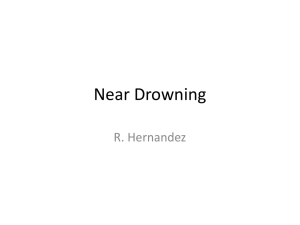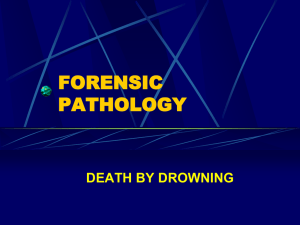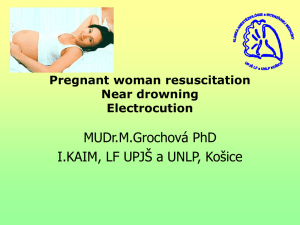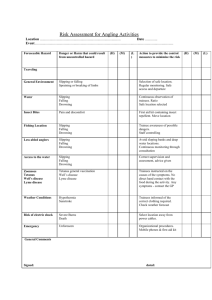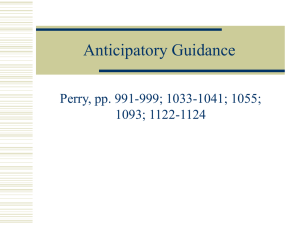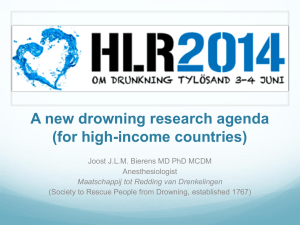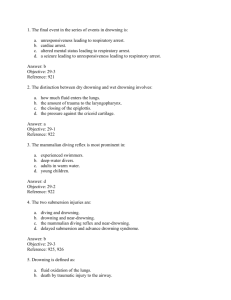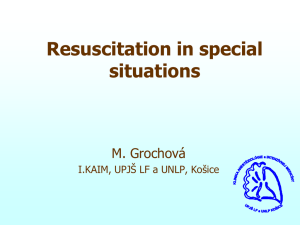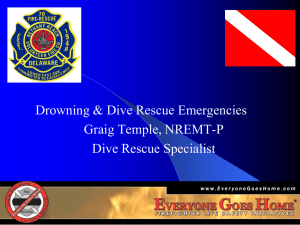MPS-19 - Drowning Chain of Survival
advertisement
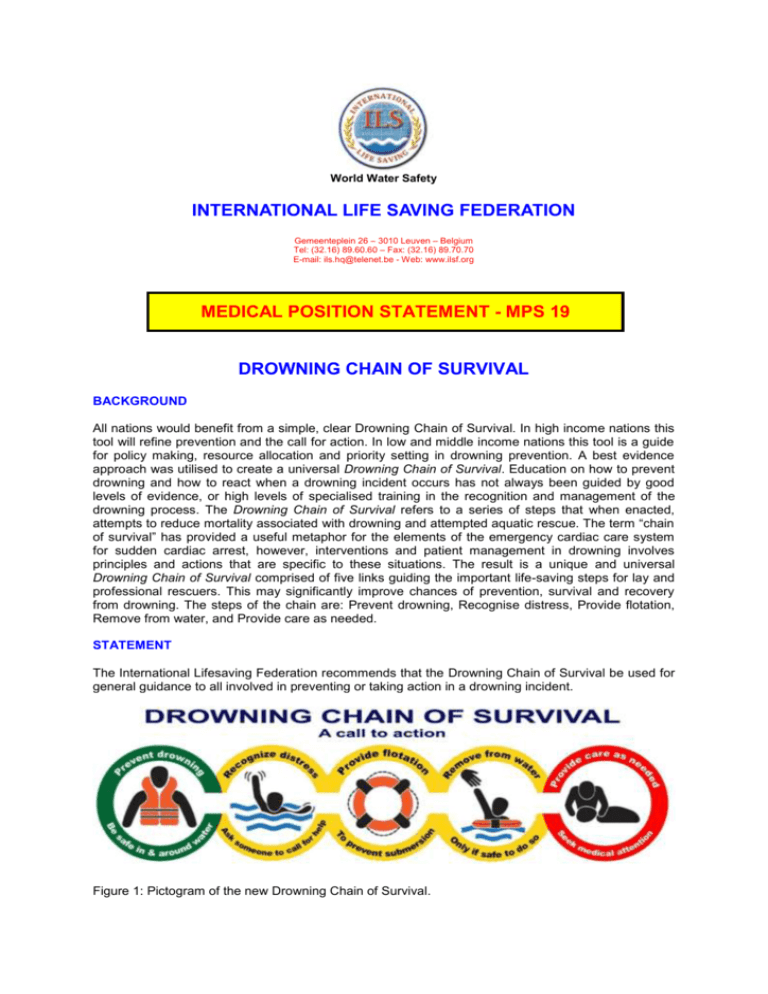
World Water Safety INTERNATIONAL LIFE SAVING FEDERATION Gemeenteplein 26 – 3010 Leuven – Belgium Tel: (32.16) 89.60.60 – Fax: (32.16) 89.70.70 E-mail: ils.hq@telenet.be - Web: www.ilsf.org MEDICAL POSITION STATEMENT - MPS 19 DROWNING CHAIN OF SURVIVAL BACKGROUND All nations would benefit from a simple, clear Drowning Chain of Survival. In high income nations this tool will refine prevention and the call for action. In low and middle income nations this tool is a guide for policy making, resource allocation and priority setting in drowning prevention. A best evidence approach was utilised to create a universal Drowning Chain of Survival. Education on how to prevent drowning and how to react when a drowning incident occurs has not always been guided by good levels of evidence, or high levels of specialised training in the recognition and management of the drowning process. The Drowning Chain of Survival refers to a series of steps that when enacted, attempts to reduce mortality associated with drowning and attempted aquatic rescue. The term “chain of survival” has provided a useful metaphor for the elements of the emergency cardiac care system for sudden cardiac arrest, however, interventions and patient management in drowning involves principles and actions that are specific to these situations. The result is a unique and universal Drowning Chain of Survival comprised of five links guiding the important life-saving steps for lay and professional rescuers. This may significantly improve chances of prevention, survival and recovery from drowning. The steps of the chain are: Prevent drowning, Recognise distress, Provide flotation, Remove from water, and Provide care as needed. STATEMENT The International Lifesaving Federation recommends that the Drowning Chain of Survival be used for general guidance to all involved in preventing or taking action in a drowning incident. Figure 1: Pictogram of the new Drowning Chain of Survival. International Life Saving Federation Medical Position Statement – MPS-19. Drowning Chain of Survival Page 2 LEVEL OF EVIDENCE This statement is based on expert consensus. DISCUSSION The term “Chain of Survival” has provided a useful metaphor for the elements of the emergency cardiac care system for sudden cardiac arrest, however, interventions in drowning involves principles and actions that are specific to these situations. A unique and universal Drowning Chain of Survival can guide the important life-saving steps for lay and professional rescuers. This may significantly improve chances of prevention, survival and recovery for people in potential danger in water. Prevention is the most important contributor to reduce drowning mortality and morbidity. In low and medium income countries (LMIC) where more than 90% of the global drowning occurs, guidance to accelerate culturally appropriate prevention, rescue and resuscitation strategies are most urgently needed.1 High income countries (HIC) have seen dramatic reductions in drowning mortality as a result of reduced risks and effective strategic interventions. Further mortality reduction can be facilitated with the introduction of effective approaches to prevention, rescue and resuscitation in LMIC settings.2 When preventative measures fail, responders need to be able to perform the necessary steps to interrupt the drowning process. The first challenge is to recognise someone in distress and the need to activate rescue and emergency medical services (EMS) appropriately when possible. It is critical that rescuers take precautions not to become another victim by engaging in dangerous behaviors. 3 Early rescue may prevent initial and subsequent water aspiration, respiratory distress and medical complications. The entire drowning process, from submersion/immersion to cardiac arrest usually occurs in a very short space of time.4 If the person is rescued alive, the clinical picture is determined predominantly by the amount of water that has been aspirated. In some cases, even an early and effective rescue will not prevent the medical consequences and in these cases basic and advanced life support interventions may be required.5 An effective educational strategy on drowning can assist both LMIC and HIC responders to recall important preventative measures as well as critical response steps. One such strategy has involved promoting icons in the form of a Drowning Chain of Survival. 6,7 The purpose of this concept is to describe the development of a new and universal Drowning Chain of Survival for the prevention and effective response to drowning incidents based on conceptual, practical, and educational value. REVIEWING CONCEPTS AND MODELS In 2013, a group of experts reviewed the need to update the existing Drowning Chain of Survival by examining all elements of current and similar models. The four major elements of the European Resuscitation Council (ERC) and five major elements of the American Heart Association (AHA) chains of survival were evaluated from an applicability to drowning perspective.8 The first6 Drowning Chain of Survival developed in 2002 resulted from a realisation that drowning prevention and first aid education had several unique characteristics not captured in the emergency cardiovascular care (ECC) chains of survival. Basic and advanced life support in the aquatic environment requires specific skills and knowledge that were not taught in regular first aid and cardiopulmonary resuscitation (CPR) education.9 The result was an original Drowning Chain composed of icons that formed 6 links.6 The 2012 “Drowning Response” adopted by the American Red Cross (ARC) was reviewed.10 The ARC Drowning Response chain did not include prevention; instead it addressed the key evidencebased effective drowning prevention strategies by developing a specific Circle of Prevention. 10 International Life Saving Federation Medical Position Statement – MPS-19. Drowning Chain of Survival Page 3 The “Call to Action” system used by Surf Life Saving New Zealand was also reviewed. It includes a “provide flotation” link as a priority intervention, emphasises the importance of rescuer safety, and omits links that duplicate information already contained in the ECC Chain of Survival. 8,11 A Delphi-like process among experts was performed by email previously to the workshop at the World Conference on Drowning Prevention in 2013 (WCDP-2013) where conceptual, practical, and educational values were examined supported by medical, pedagogical and lifeguarding science. A facilitated discussion identified ways to evaluate whether the proposed model would meet the needs of all layers of prevention and response, as well as complying with International Organisation for Standardisation (ISO) requirements. In closing the session at the WCDP-2013 a final summary including all the relevant ideas, identifying key areas of agreement and unresolved issues was presented. After the workshop, input from the participants continued to be collated and refined. RESULT A new concept of a Universal Drowning Chain of Survival containing 5 links is described. Figure 1: Drowning Chain of Survival. “PREVENT DROWNING - Be safe in & around the water” It has been estimated that most deaths by drowning are preventable. The ability to avoid a drowning contrasts with the high rates of poor outcomes following these type of incidents. Drowning requires multiple layers of protection. To be effective, drowning prevention must be used by individuals near, on or around the water, and those who supervise or care for others in water settings. 12 MAJOR ADVICE ACTIONS Stay within arm’s reach of children when in or near the water. Swim where there are lifeguards. Fence pools, spas and other aquatic locations with 4-sided fencing. Always wear a lifejacket when using watercraft (e.g. boat, kayak etc.) Learn how to swim and water-safety survival skills. “RECOGNISE DISTRESS - Call for help” The first challenge is to recognize a person in distress in the water and know how to act safely, and to activate the lifeguard, rescue and emergency medical services (EMS) if possible and available. Frank Pia contradicted the prevailing notions that most victims struggle at the water’s surface, call or wave for help, and actively attack rescuers. He showed that a person struggling and about to drown cannot usually call for help.4 In 1995, Langendorfer & Bruya identified key developmental components of aquatic readiness and water competency and a Drowning Risk Assessment was created. Identified recognisable 13 International Life Saving Federation Medical Position Statement – MPS-19. Drowning Chain of Survival Page 4 elements of a person at high risk of drowning include: Near vertical body position, ineffective downward arm movements, ineffective pedalling or kicking leg action, and little or no forward progress in water.14 Sending someone to call for help upon recognising a person in distress is a key element in the drowning response chain. Delays in activating EMS/rescue services increases the risk of fatal drowning.3 MAJOR ADVICE ACTIONS Recognise early drowning victim’s distress signs. Victims may not wave or call for help. Tell someone to call for help while staying on-scene to provide assistance. Watch where the victim is in the water, or ask a bystander to keep constant watch. “PROVIDE FLOTATION – to prevent submersion” After recognising a victim is in distress and asking someone to call for help, the next priority is to interrupt the drowning process by providing flotation to the victim. Providing flotation is a strategy not widely employed despite buying valuable time for emergency services to arrive, or for those at the scene to plan rescue efforts. Most rescuers tend to focus on the strategic goal of getting the victim out of the water even if there is a high threat to life/rescuer safety.15 Devices such as lifebuoys (ring-buoys ) are purpose-designed to provide flotation. However, they are not always available at the scene of a drowning incident. Therefore, improvised buoyancy aids such as empty plastic bottles/containers, body boards, surfboards, driftwood, icebox, or a football etc. could be used. It is critical that lay persons take precautions not to become another victim by engaging in inappropriate/dangerous behaviour.3 Given the number of bystanders who drown while attempting to rescue others, reaching out with, throwing, or dropping the buoyancy aid without entering the water is the safest course of action.16 MAJOR ADVICE ACTIONS While helping others: Stay out of the water to reduce rescuer risk. Throw something that floats to the victim. To help yourself: If you are in difficulty, don´t panic; stay with any flotation you may have. Signal for help as soon as and if possible, and float. “REMOVE FROM WATER – Only if safe to do so” Removing the victim from the water is essential in order to provide a definitive end to the drowning process. Several strategies for removal can be used: Assist the victim to get out of the water by giving directions, i.e. pointing out to the closest and safest place to get out. Attempt to remove the victim without fully entering the water by utilising rescue techniques such as, reaching, throwing and wading out with equipment; If all else fails, the lay rescuer may then consider entering the water if it is safe to do so. The entry of an untrained person into the water to rescue someone is extremely dangerous and is not recommended. 3,16 In order to mitigate the risk during a rescue, a rescuer must bring a source of flotation as to assist the victim. MAJOR ADVICE ACTIONS Assist the victim on how to self-rescue by giving them directions for getting out of the water. Try to remove the victim without entering the water. Only if safe to do so, rescue the victim using any flotation available. “PROVIDE CARE AS NEEDED – Seek medical attention” Basic life support for drowning patients is unique due to the dangerous environment which may pose some difficulties in providing care before, during or after the rescue process. The need for, and initiation of basic life support may occur while the victim is still in water if the rescuer is trained and can provide in-water resuscitation safely.5, 21 If not interrupted, the drowning process leads to apnoea followed by cardiac arrest within minutes. Any attempt to immobilise the spine International Life Saving Federation Medical Position Statement – MPS-19. Drowning Chain of Survival Page 5 will impede rescue, and more importantly delay resuscitation. Therefore, attempts to immobilise the spine should only be made where there is strong evidence of cervical spine injury. 17 Transporting and positioning drowning victims also requires specialised adaptations.18 Cardiopulmonary Resuscitation (CPR) is needed when the heart stops following a period of apnea.5 Initial ventilations may be ineffective in drowning due to the presence of water in the upper airway.5 Airway management is always challenging due to vomiting/ regurgitation and the fluid that is commonly present in the upper airway. Also unique to drowning is that the most common rhythm in cardiac arrest following drowning is asystole. As soon as the victim is removed from the water, rescuers must recognise the drowning severity especially if there is a life-threatening situation so immediate care can be provided.20 As the majority of people with mild distress may not actually aspirate water it is important to educate responders when to call the ambulance or seek medical assistance/hospital care. 20 MAJOR ADVICE ACTIONS If not breathing, start CPR as per local resuscitation guidelines immediately.20 Consider the use of oxygen and an automated external defibrillator as soon as possible if available. If breathing, stay with victim until help arrives.20 Seek medical aid/hospital if any symptoms are present, and for all victims who require resuscitation.20 SUMMARY Education on how to prevent and to how act when a drowning incident occurs has not been guided by high-level evidence. The concept of having a suggested course of action for drowning is not new, but has never had worldwide acceptance, and never been adopted as a standard of care, instruction or communication. Other “chains” have been developed along similar lines such as the Drowning Prevention Chain used by the International Lifesaving Federation 22 and the Chain of Drowning Survival used by the American Red Cross 23 During the process of establishing a new and universal Drowning Chain of Survival the authors faced many challenges. The major issues were: the diversity of how drowning is perceived around the world, the heterogeneity of knowledge, existing drowning response models, how best to reconfigure the chain and the evaluation of compliance with international signage standards so “one shoe could fit all”. As work on the model progressed, it became evident that the simpler the message the more acceptable and widely used it would be for different scenarios and levels of rescuer-experience. The resultant new Drowning Chain of Survival does not prescribe specific advice but rather gives general guidance to all involved in preventing or taking action in a drowning incident. Although a consensus on a new Drowning Chain of Survival has resulted from this process, the model still needs to be accepted, used, and validity-tested in different aquatic scenarios and with groups of professionals to lay persons, in HIC and LMIC settings, that may be called upon to respond in an aquatic emergency. POTENTIAL CONFLICT OF INTEREST STATEMENT The authors have no conflict of interest with the stakeholder industry, technology, persons or organisations that are identified and/or impacted by the position statement. Authors: Dr. David Szpilman, MD: david@szpilman.com Jonathon Webber: j.webber@aquasafenz.com Prof. Dr. Linda Quan, MD: linda.quan@seattlechildrens.org Prof. Dr. Joost Bierens, MD, PhD : jbierens@euronet.nl Luiz Morizot-Leite, morizot@miamidade.gov Stephen John Langendorfer: slangen@bgsu.edu International Life Saving Federation Medical Position Statement – MPS-19. Drowning Chain of Survival Page 6 Dr. Steve Beerman, MD: sbeerman1@gmail.com Prof Dr. Bo Løfgren, MD, PhD: bo.loefgren@ki.au.dk Acknowledgement: - The authors thank Mrs Maria Alice Szpilman and Mr Leonardo Springer for assisting in the development of the new Drowning Chain of Survival graphical design. REFERENCES 1. Rahman A, et al, Analysis of the childhood fatal drowning situation in Bangladesh, exploring prevention measures in lowincome countries Injury. Prevention 2009:15,75-79 2. WHO/UNICEF Child Injury Prevention 2008 3. Venema AM, Groothoff JW, Bierens JJLM. The role of bystanders during rescue and resuscitation of drowning victims. Resuscitation 2010;81:434-9. 4. Pia, F. Observations on the Drowning of Non-swimmers. Journal of Physical Education. 1974; 71(6), p164-67 and 181. Retrieved from http://www.pia-enterprises.com/Observations.pdf 5. Szpilman D, Bierens JJLM, Handley AJ, Orlowski JP. Drowning: Current Concepts. N Engl J Med 2012;366:2102-10 6. Szpilman D, Morizot-Leite L, Vries W, Scarr J, Beerman S, Martinhos F, Smoris L, Løfgren B; First aid courses for the aquatic environment; section 6(6.7). Resuscitation, in Hand Book on Drowning:Prevention, Rescue and Treatment, edited by Joost Bierens,Springer-Verlag, 2005, pg 342-7. 7. Wilson-Saliba L. Does the teaching of water safety and swimming reduce the incidence of death by drowning? World Water Safety, Matosinhos – Portugal 2007; Book of Abstracts, ISBN: 978-989-95519-0-9, p244. 8. Field JM, Hazinski MF, Sayre MR, Chameides L, Schexnayder SM, Hemphill R, Samson RA, Kattwinkel J, Berg RA, Bhanji F, Cave DM, Jauch EC, Kudenchuk PJ, Neumar RW, Peberdy MA, Perlman JM, Sinz E, Travers AH, Berg MD,Billi JE, Eigel B, Hickey RW, Kleinman ME, Link MS, Morrison LJ, O’Connor RE, Shuster M, Callaway CW, Cucchiara B, Ferguson JD, Rea TD, Vanden Hoek TL. Part 1: executive summary: 2010 American Heart Association Guidelines for Cardiopulmonary Resuscitation and Emergency Cardiovascular Care. Circulation. 2010;122(suppl 3): S640–S656. 9. Deakin CD. Tailoring bystander CPR- a step too far? Resuscitation. 2012 Jan;83(1):134-7. 10. Quan, L., et al. American Red Cross preventative and response chain of survival for drowning. Scientific Advisory Council – Aquatic Sub Council, 2012. 11. Webber, J. Surf Lifeguard Response to Drowning: the SENTINEL system revisited. Paper presented at the Lifesaving Foundation Drowning Prevention and Rescue Conference, 2012, September. Ireland. 12. Moran K, Quan L, Franklin R, Bennett E. Where the Evidence and Expert Opinion Meet: A Review of Open-Water: Recreational Safety Messages. International Journal of Aquatic Research and Education, 2011, 5, 251-270 13. Langendorfer SJ. Applying a development perspective to aquatics and swimming. In: Kjendlie PL, Stallman RK, Cabri J (eds.). Biomechanics and Medicine in Swimming XI. 2010.p20-22. Norwegian School of Sport Sciences. Oslo 14. Lanagan-Leitzel LK. Identification of critical events by lifeguards, instructors, and non-lifeguards. International Journal of Aquatic Research and Education 08/2012;6(3):203-214. 15. Water Safety New Zealand. Drowning statistics 1980‐2012 where the victim has been attempting to rescue others [Dataset]. 2013. Retrieved from DrownBase™ database. 16. Turgut A., Turgut B. A study on rescuer drowning and multiple drowning incidents. Journal of Safety Research 2012;43, 129-132. doi:10.1016/j.jsr.2012.05.001 17. Soar J, Perkins GD, Abbasc G, et al. European Resuscitation Council Guidelines for Resuscitation 2010. Section 8.Cardiac arrest in special circumstances: electrolyte abnormalities, poisoning, drowning, accidental hypothermia, hyperthermia, asthma, anaphylaxis, cardiac surgery, trauma, pregnancy, electrocution. Resuscitation 2010;81:1400-33. 18. Szpilman D, Handley A. Positioning the drowning victim. In: Bierens JJLM, ed. Handbook on drowning: prevention, rescue, and treatment. Berlin: Springer-Verlag, 2006:336-41. 19. Kitamura T, Iwami T, Kawamura T, Nagao K, Tanaka H, Nadkarni VM, Berg RA, Hiraide A. Conventional and chestcompression-only cardiopulmonary resuscitation by bystanders for children who have out-of-hospital cardiac arrests: a prospective, nationwide, population-based cohort study. Lancet 2010;375:1347–54. 20. Szpilman D. Near-drowning and drowning classification: a proposal to stratify mortality based on the analysis of 1831 cases. Chest 1997;112:660-5. 21. International Lifesaving Federation Position Statement MPS-08 In Water Resuscitation. http://www.ilsf.org/about/positionstatements 22. International Lifesaving Federation, Drowning Prevention Strategies, A framework to reduce drowning deaths in the aquatic environment for nations/regions engaged in lifesaving. http://www.ilsf.org/drowning-prevention/library/total-life-savingservice-plan 23. American Red Cross scientific advisory council. Circle of Drowning Prevention and Chain of Drowning Survival. http://www.redcross.org/search/index.jsp?_DARGS=/jspf/modules/nav/primary-navtemp.jsp The published version of this manuscript can be found at: Szpilman D, et al. Creating a drowning chain of survival. Resuscitation (2014), http://dx.doi.org/10.1016/j.resuscitation.2014.05.034 Statement authorised by the ILS Medical Committee and Rescue Commission. Policy Statement approved by the ILS Board of Directors: 16 September 2014.
